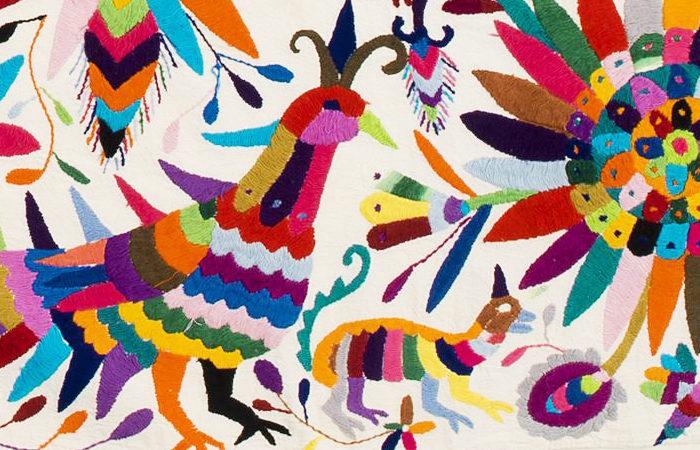Otomi Embroidery
29th June 2018
Otomi embroidery is an embroidery style created by the Otomi people of central Mexico that has become popular in recent years. Often worked in a riot of colour, we can’t help but be amazed by the careful workmanship of this ancient and traditional style.

Otomi tenango from Mexico, courtesy Museum of Applied Arts & Sciences (source)
The colours are in such stark contrast to our surrounds here in Adelaide where, like other areas in the southern hemisphere, winter is encroaching, and everything is becoming greyer, darker and leached of colour. In response many of us unconsciously dress in colours that match the winter sky, relegating our vibrant summer clothing to the wardrobe for the duration of the season.
So if you, like us, need an antidote to the winter blues, or even if the sun is shining where you live and you’re looking for something to celebrate summer fun, the colours of the tenagos or embroidered textiles of the Otomi people are calling your name.

The Otomi have been embroidering for centuries, but the embroideries we see today evolved out of the desperate need of the people to find a source of income after severe droughts wracked the country in the 1960s.

The designs are filled with symbols based on native flora and fauna, local beliefs and even primitive cave drawings found in the Hidalgo region where many of the Otomi reside.
Animals, often thought to be the bearers of important news; stars representing the cardinal direction; flowers and plants representing fertility and nature and even spirits, both helpful and harmful adorn the pieces which are then made into tablecloths, bed linens or wall hangings to sell at the local markets.

Left: Elvira Clemente Gomez’s piece showing life in a village in Hidalgo. Right: Working on a piece in Tenago de Doria. Courtesy: Thelmadatter – Own work, CC BY-SA 4.0 (source)
Although there is often symmetry in each piece, no two pieces are identical, just as no two motifs within a piece are identical due to the importance of hand sketching the initial design.
We know that embroidery takes time, but some of these pieces can take the makers months or even years to finish.
Nevertheless, imagine the joy in selecting the colours and the pleasure in seeing the completed work. Although genuine Otomi embroideries are available for sale in Mexico, the price one would pay would only represent a fraction of the time, creativity and soul injected into each piece.

Close up of the back of the Otomi tenango from Mexico, Courtesy Museum of Applied Arts & Sciences (source)
Despite the age of this traditional embroidery style, any of these pieces would fit into a modern home. It makes you want to discard your patterns, get out a pencil and a bag of mixed threads in a rainbow of colours and just let yourself go, doesn’t it?
